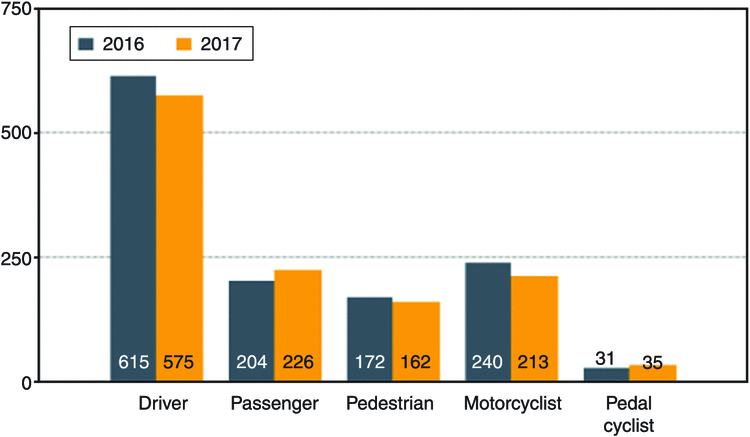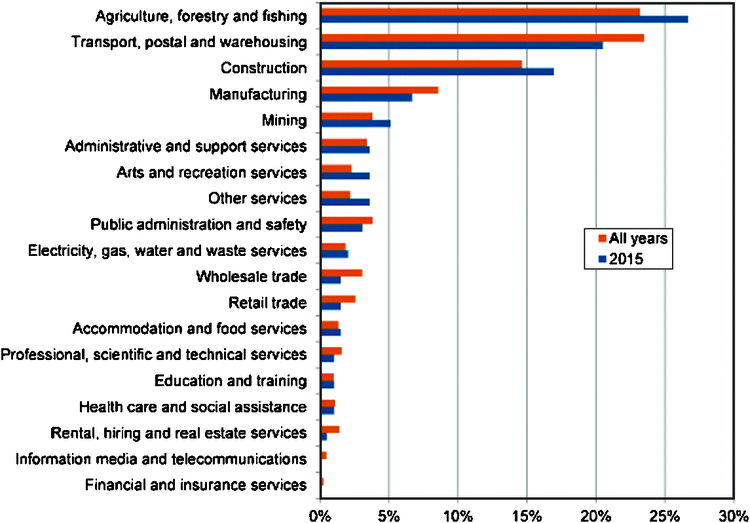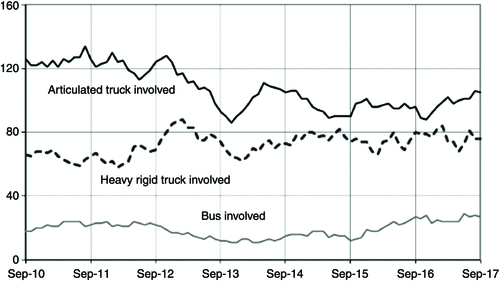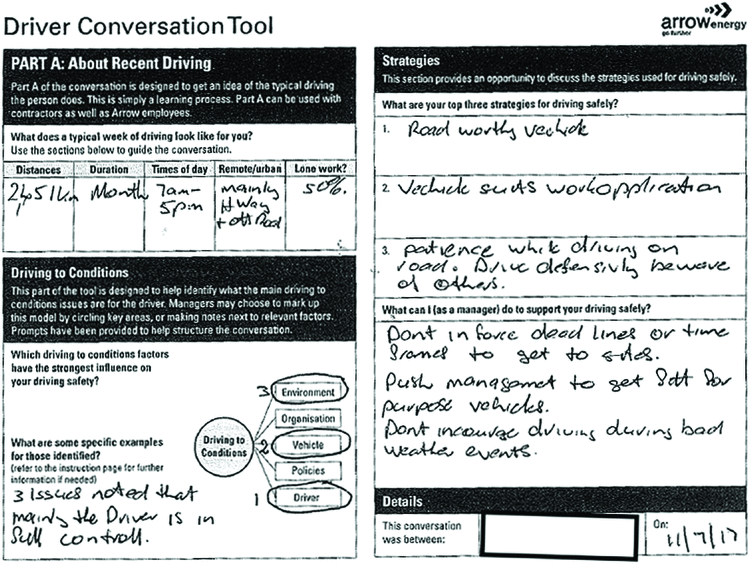Working together to reduce land transport safety risk in the CSG sector: can we ever do enough?
Michelle Zaunbrecher A B , Jason King A B and Brandon Yeong A BA Arrow Energy, Level 39, 111 Eagle Street, Brisbane, Qld 4000, Australia.
B Corresponding authors. Email: Michelle.Zaunbrecher@arrowenergy.com.au; Jason.King@arrowenergy.com.au; Brandon.Yeong@arrowenergy.com.au
The APPEA Journal 58(1) 25-31 https://doi.org/10.1071/AJ17081
Submitted: 1 December 2017 Accepted: 5 February 2018 Published: 28 May 2018
Abstract
Queensland coal seam gas (CSG) company, Arrow Energy (Arrow), has been implementing a strategy to improve land transport safety across its business. The present paper examines the strategy Arrow has taken to better understand and mitigate the risks associated with land transport. It looks at current transport risk, specific examples of existing good practice adopted by Arrow and future opportunities.
Land transport-related incidents have historically been the main cause of fatalities in this sector. To address this risk, Arrow has developed a seven-pillar strategy, comprising safe vehicles, safe drivers, safe speeds, safe roads, Arrow assurance program, industry collaboration and contracting strategy. The strategy applies equally to light and heavy vehicles and both professional and non-professional drivers. The unique approach focuses on changing driver behaviours, having a robust assurance and controls program, appointing a third party logistics (3PL) specialist transport provider and developing key relationships with contractors and internal stakeholders.
A continuous improvement approach to safety culture, positive driving behaviours, transport safety education, industry focus group participation (Safer Together), better vehicle technical standards, and having supplier relationships to drive outcomes will further ensure that land transport safety is a key priority across the business. Arrow believes this integrated approach yields the best results, but that it is an ongoing journey, as long as the industry has vehicles and is driving.
Keywords: assurance, coal seam gas, driving behaviours, fatalities, safe drivers, safe roads, safe speeds, safety, supplier relationships, technology, training.
Introduction
The purpose of the present paper is to examine transport risk and the strategies adopted to ensure that the risk is as low as reasonably practicable. The paper explores the strategies that Arrow has adopted for best results in working with contractors to improve safety performance. It also includes specific examples of good practices adopted by Arrow and the positive results observed from them. The paper also looks at opportunities for future improvement, to drive safety risk to an even lower level.
The present paper features Arrow Energy (Arrow), an Operator company active in the Queensland coal seam gas (CSG) sector, and examines how the company is applying a strategy to reduce land transport safety risk. Land transport-related incidents are historically the main cause of fatalities in the sector. Arrow has implemented several strategies, with a significant improvement to the number of vehicle incidents since 2011. However, it does not believe that it has solved the problem; rather, that it is on a journey to improvement.
Statistically, transport-related deaths have been the highest among work-related deaths in 2016 and 2017 (Australian Government Department of Infrastructure, Regional Development and Cities 2017a). According to Safe Work Australia (2018), in 2015, almost half (47%) of worker fatalities occurred within the transport, postal and warehousing, and agriculture, forestry and fishing industry. Figures 1 and 2 highlight the road deaths and industry types with the highest proportion of deaths.

|

|
Arrow utilises a large number of heavy vehicles as part of its transport operations both for warehouse freight movements and rig operations. In the 12 months to the end of September 2017, 216 people died in Australia from 197 fatal crashes that involved heavy trucks or buses (Australian Government Department of Infrastructure, Regional Development and Cities 2017b). Figure 3 tracks the counts of fatal crashes that involved heavy vehicles.

|
Given the significant amount of reliance on inland freight movements, land transport-related incidents are the single largest cause of fatalities in CSG company operations. It is an industry expectation that all companies operating land transport vehicles, or providing services involving land transport, have in place a management system for these operations and that this is based on a full assessment of the risks and measures to address such risks.
To address risk, Arrow has developed a multi-pronged strategy that relies on key parts of the organisation working together, notably Contracts and Procurement, Transport and Logistics and HSE. The other key aspect has been the Arrow internal contract holders and the contractors themselves that have been actively working hard to improve driver safety through regular meetings and tool box sessions. The seven pillars of Arrow’s strategy are detailed in Table 1. This strategy applies equally to light and heavy vehicles and professional and non-professional drivers.

|
There are multiple aspects to consider in managing land-transport risks. Unfortunately, there is no perfect solution where a single control will result in elimination of a land-transport risk for the resource/CSG industry.
Improvements to date and looking forward
In-vehicle monitoring system (IVMS) has helped make a dramatic change in driver behaviour, but the improvement is largely due to driver compliance. This does not take into account external factors such as road hazards, vehicle load, weather conditions, night time or personal factors such as fatigue. As such, Arrow has commenced a Driving to Conditions Conversation Program, specifically to address these factors. This program sees managers conducting one-on-one conversations with staff who have work-related driving as part of their role. The manager is prompted to consider how to help staff deal more effectively with the road and driving conditions. The aim of the program is for Arrow drivers to consciously consider driving to conditions every time they drive. This would change driver behaviour and improve their road awareness, thereby reducing transport incidents. Figure 4 shows an extract of a completed template from the Driving to Conditions Conversation Program. This tool provides a process for discussing recent driving in general, then discussing specific driving-to-conditions issues, and then discussing potential learning and/or actions.
Figure 5 summarises Arrow’s driving-related IVMS breaches since 2011. These data allow Arrow to determine any trends that may be of concern at an early stage and put in place controls to prevent them from escalating to a more serious issue.

|
Looking to the future, Arrow believes that driving to conditions is critical to protect the safety of its drivers and other road users. Further development of initiatives to promote awareness of driving to conditions will include using technology to assist drivers. For example, development of a GIS road map with geographically linked speed zone changes and road hazards, then linked to voice technology for advance notifications, is under development to further improve driver safety. Imagine a driving experience where voice technology informs the driver well in advance of approaching speed limit changes, and associated road hazards such as narrow bridges, tight corners, river crossings, loose gravel or busy crossroads. Voice technology would inform the driver of the speed zone changes and would remove the punitive nature of the IVMS arrangements. This allows drivers to better focus on driving and reduce any unnecessary distractions.
Conclusions
In conclusion, land transport safety is an ongoing and evolving challenge for Arrow and the CSG industry. The present paper has highlighted the importance of having an overall land transport strategy, provided examples of good practices that have worked for Arrow and looked at further improvements. Opportunities for better outcomes exist with targeting safety culture and driving behaviour through transport safety education, industry focus group participation (Safer Together), better vehicle technical standards and having supplier relationships to drive outcomes.
The area that offers significant opportunity for safety improvement is encouraging drivers to consciously consider driving to conditions every time they drive. Arrow has embarked on this journey with the Driving to Conditions Conversation Program. In the near future, the company will use technology to further enhance driver safety.
Arrow, and the Queensland CSG industry, must continue to strive to make the land transport risk component of our operations as low as reasonably practicable, so as to ensure the safety of staff and other road users.
Arrow believes that all staff and contractors play an important role in reducing safety incidents by sharing and learning from our collective experiences.
Conflicts of interest
None.
References
Arrow Energy (2017a). Seven pillar strategy. Arrow Energy, Brisbane. [Unpublished]Arrow Energy (2017b). Driver conversation tool. Arrow Energy, Brisbane. [Unpublished]
Arrow Energy and Contractor (2017) Summary of IVMS breaches (trend analysis). Arrow Energy, Brisbane. [Unpublished]
Australian Government Department of Infrastructure, Regional Development and Cities (2017a). Road safety statistics October 2017. Available at https://bitre.gov.au/statistics/safety/index.aspx [verified 1 December 2017]
Australian Government Department of Infrastructure, Regional Development and Cities (2017b). Fatal heavy vehicle crashes Australia – quarterly bulletins October 2017. Available at https://bitre.gov.au/publications/ongoing/fatal_heavy_vehicle_crashes_quarterly.aspx [verified 1 December 2017]
Safe Work Australia (2018). Fatality statistics. Available at https://www.safeworkaustralia.gov.au/statistics-and-research/statistics/fatalities/fatality-statistics [verified 1 December 2017]

Michelle Zaunbrecher has a Geology and Honours Degree in Petroleum Geology and Geophysics. She also has a Masters of Environmental Science and Hydrogeology. Michelle has over 25 years in the resource sector, mostly in the oil and gas area. She has worked for BHP Billiton, BP and is currently the Vice President Health, Safety and Environment for Arrow Energy. |

Jason King is currently the General Manager – Contracting, Procurement and Logistics at Arrow Energy. Prior to joining Arrow, Jason led the Ernst and Young’s Brisbane Supply Chain Advisory group and founded KPMGs Business Performance Services team in Queensland. He has over 25 years of experience in Management Consulting within the private and public sector in the United Kingdom, Europe, Asia Pacific and the Americas. Jason has covered a broad number of other senior global roles in transformation and implementation experience, including Strategic Sourcing Manager, Program Management, Global Project Delivery, Global Functional Procurement Lead, Technical Project Management. Jason has worked with several global Mining, Metals and Oil and Gas companies on global sourcing strategies for emerging markets, cost reduction, EBIT and Working capital optimisation, strategic sourcing in Vietnam, China, Indonesia, Thailand and Malaysia. Jason has also extensive experience in integration projects and global ERP Implementations, Transformation, strategic sourcing and IT procurement projects. |

Brandon Yeong is responsible for warehousing, inventory and contracting at Arrow Energy. He is an experienced supply chain practitioner with particular expertise in the oil and gas sector. Prior to joining Arrow Energy, Brandon has over 10 years of consulting and commercial experience in industries covering mining, oil and gas, aviation, FMCG, manufacturing, utilities, construction, government and telecommunications. Brandon’s consulting experience includes working at leading firms such as Accenture, KPMG and Ernst and Young. Brandon has led a wide range of projects across the Asia Pacific, focusing on strategy development, operational and process improvement and technology implementation. Brandon also has significant experience in planning and integrating large-scale transformation projects and business consulting at senior and executive levels. Brandon holds a Bachelor of Finance and Masters of Business Administration from the University of Queensland. |



